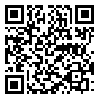Volume 18, Issue 3 (September 2020)
Iranian Rehabilitation Journal 2020, 18(3): 309-318 |
Back to browse issues page
Download citation:
BibTeX | RIS | EndNote | Medlars | ProCite | Reference Manager | RefWorks
Send citation to:



BibTeX | RIS | EndNote | Medlars | ProCite | Reference Manager | RefWorks
Send citation to:
Agha Mohammad Hasani P, Sheikh Fathollahi M, Gerami Fard A, Mokhtari M. Effectiveness of Happiness Training on the Pattern of Parent-Child Relationships and the Hope of Parents With Autistic Children. Iranian Rehabilitation Journal 2020; 18 (3) :309-318
URL: http://irj.uswr.ac.ir/article-1-1065-en.html
URL: http://irj.uswr.ac.ir/article-1-1065-en.html
Parvin Agha Mohammad Hasani1 

 , Mahmood Sheikh Fathollahi2
, Mahmood Sheikh Fathollahi2 

 , Asal Gerami Fard3
, Asal Gerami Fard3 

 , Mohammadreza Mokhtari *4
, Mohammadreza Mokhtari *4 




 , Mahmood Sheikh Fathollahi2
, Mahmood Sheikh Fathollahi2 

 , Asal Gerami Fard3
, Asal Gerami Fard3 

 , Mohammadreza Mokhtari *4
, Mohammadreza Mokhtari *4 


1- Department of Psychiatry, Clinical Research Development Unit (CRDU), Moradi Hospital, Rafsanjan University of Medical Sciences, Rafsanjan, Iran.
2- Department of Epidemiology, Biostatistics and Occupational Environment Research Center, School of Medicine, Rafsanjan University of Medical Sciences, Rafsanjan, Iran.
3- Clinical Research Development Unit (CRDU), Moradi Hospital, Rafsanjan University of Medical Sciences, Rafsanjan, Iran.
4- Department of Psychology and Education, Kerman Branch, Islamic Azad University, Kerman, Iran.
2- Department of Epidemiology, Biostatistics and Occupational Environment Research Center, School of Medicine, Rafsanjan University of Medical Sciences, Rafsanjan, Iran.
3- Clinical Research Development Unit (CRDU), Moradi Hospital, Rafsanjan University of Medical Sciences, Rafsanjan, Iran.
4- Department of Psychology and Education, Kerman Branch, Islamic Azad University, Kerman, Iran.
Abstract: (3715 Views)
Objectives: Families of children with special needs face many problems. This study aimed to investigate happiness training on the pattern of parent-child relationships and the hope of parents with autistic children.
Methods: Twenty-six couples with autistic children who referred to Rafsanjan Autism Clinic, Rafsanjan City, Iran, were enrolled in the study by the census method. Informed consent was obtained from them. Then the parents completed the Schaefer and Edgerton Parent-Child Interaction Questionnaire (1985) and Miller Hope Scale (1988). Next, parents were randomly assigned to the intervention or control groups. Happiness training based on the Fordyce method was performed for eight 1.5-hour sessions per week for the intervention group. The parents of either group completed the questionnaires after training of the intervention group (about 2 months and 3 months later). The Chi-square test, independent t-test, and 2-way repeated-measures ANOVA were used for statistical analysis. The level of significance was set at 0.05.
Results: The results of the analysis showed that the changes in the scores of communication (P=0.013), acceptance (P=0.008), control (P=0.005), independence (P=0.040), aggressive non-attachment (P=0.015), and hope (P=0.010) were significant between the two groups at stages of measurement. The scores of all variables increased but the aggressive non-attachment decreased.
Discussion: The education of happiness in Fordyce style influenced the interactive pattern of communication and hope of parents with autistic children. Therefore, training of happiness along with other services available to parents of autistic children can also be considered.
Methods: Twenty-six couples with autistic children who referred to Rafsanjan Autism Clinic, Rafsanjan City, Iran, were enrolled in the study by the census method. Informed consent was obtained from them. Then the parents completed the Schaefer and Edgerton Parent-Child Interaction Questionnaire (1985) and Miller Hope Scale (1988). Next, parents were randomly assigned to the intervention or control groups. Happiness training based on the Fordyce method was performed for eight 1.5-hour sessions per week for the intervention group. The parents of either group completed the questionnaires after training of the intervention group (about 2 months and 3 months later). The Chi-square test, independent t-test, and 2-way repeated-measures ANOVA were used for statistical analysis. The level of significance was set at 0.05.
Results: The results of the analysis showed that the changes in the scores of communication (P=0.013), acceptance (P=0.008), control (P=0.005), independence (P=0.040), aggressive non-attachment (P=0.015), and hope (P=0.010) were significant between the two groups at stages of measurement. The scores of all variables increased but the aggressive non-attachment decreased.
Discussion: The education of happiness in Fordyce style influenced the interactive pattern of communication and hope of parents with autistic children. Therefore, training of happiness along with other services available to parents of autistic children can also be considered.
Article type: Original Research Articles |
Subject:
Psychology
Received: 2019/08/31 | Accepted: 2020/08/13 | Published: 2020/09/1
Received: 2019/08/31 | Accepted: 2020/08/13 | Published: 2020/09/1
Send email to the article author





